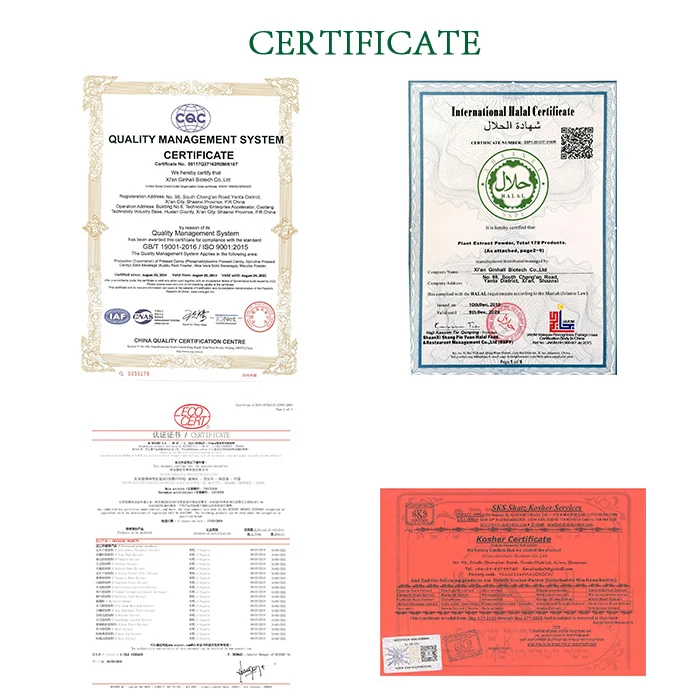Tetrahydrocurcumin 98% 36062-04-1Curcumin Extract Decolorization Tetrahydrocurcumin for whiting
Other recommendations for your business
Product Description
Tetrahydrocurcumin 98% 36062-04-1Curcumin Extract Decolorization Tetrahydrocurcumin for whiting
Product name:Tetrahydrocurcumin
Specifications: 98%
CAS:36062-04-1
Appearence:Off-white Crystalline Powder
COA:Provide
grade:cosmetics grade
Topical delivery of tetrahydrocurcumin lipid nanoparticles effectively inhibits skin inflammation: in vitro and in vivstudy.Tetrahydrocurcumin (THC) also referred to as 'white curcumin', is a stable colorless hydrogenated product of curcumin with superior antioxidant and anti-inflammatory properties
Detailed Images
Products name: | Tetrahydrocurcumin |
36062-04-1 | |
Apperance:
| Off-white Crystalline Powder |
Active Ingredient
|
Curcumin
|
Grade:
|
Food Grade
|
Test Method
|
HPLC
|
Application
|
Health-care Products
|
Specification
| 98% |
Function&Application
Function: Tetrahydrocurcumin Benefits for Skin
Compared with curcumin, tetrahydrocurcumin is more stable, and has higher antioxidant activity. So its bioavailability is higher than curcumin. Tetrahydrocurcumin uses is more extensive, but the basic effects are same.
(1) Whitening Tetrahydrocurcumin can effectively inhibit tyrosinase. It slows down melanin formation. And it is more effective than other whitening agents such as kojic acid, arbutin, and vitamin C. At the same time, tetrahydrocurcumin ‘s powerful antioxidant activity of can also delay the formation of melanin. Thereby it brightens skin and exerts a whitening effect. A study is randomized by double-blind, placebo-controlled trial of 50 subjects. The researchers found that in whitening formulations, 0.25% tetrahydrocurcumin cream is more effective and safer than 4% hydroquinone cream.
(2) Anti-oxidatio
Free radicals on skin surface are caused by UV rays, chemicals or other factors that catalyze skin aging. Tetrahydrocurcumin scavenges free radicals and prevents the formation of free radicals. In addition, tetrahydrocurcumin can inhibit the proliferation of free radicals; also it inhibits the oxidation of fat. Therefore, tetrahydrocurcumin can be added as a natural antioxidant to extend the shelf life of cosmetics.
(3) Anti-inflammation
Tetrahydrocurcumin has a broad-spectrum anti-inflammatory and antibacterial effect. It can repair skin inflammation and skin damage caused by UVB. It can more effectively relieve pain and swelling, and has a significant effect on treatment of mild burns, skin inflammation and acne scars.
(4) Repairing wound
Tetrahydrocurcumin is demonstrated to promote the production of transforming growth factor- beta (TGF-β), collagen and the regeneration of epidermal cells.
5. Tetrahydrocurcumin Uses
Because curcumin is yellow and low in cost, it is often used as an active ingredient in health care products and functional foods, or as a natural coloring agent in foods.
The anti-inflammatory function of tetrahydrocurcumin combined with its high-efficiency antioxidant effect makes it an effective ingredient in anti-aging and whitening cosmetics. Therefore, Tetrahydrocurcumin is used in high-end cosmetics.
Compared with yellow curcumin (also turmeric root extract, tetrahydrocurcumin is one of hydrogenated derivatives), Plamed tetrahydrocurcumin is white powder; it is more suitable for preparation into cosmetics.
6. Tetrahydrocurcumin Using Tips in Cosmetics Formulation
Adopt stainless steel vessel when preparing cosmetics; avoid contact with metals, such as iron and copper;
Dissolve first using a solvent, then add to emulsion at 40°C or lower temperature;
The pH of the formulation is recommended to be slightly acidic, preferably between 5.0 and 6.5;
Tetrahydrocurcumin is very stable in 0.1M phosphate buffer;
Tetrahydrocurcumin can be gelled by using thickeners including carbomer, lecithin;
Suitable for preparation into skin care products such as creams, gels and lotions;
Act as preservative and photo-stabilizers in cosmetic formulations; the recommended dosage is 0.1-1%;
Dissolve in ethoxydiglycol (a penetration enhancer); partially soluble in ethanol and isosorbide; soluble in propylene glycol at a ratio of 1:8 at 40°C; insoluble in water and glycerin.
7. Tetrahydrocurcumin Dosage in Cosmetics
Application Recommended dosage
Anti-aging and anti-oxidation 0.1-0.3%
Skin- Lightening 0.3-0.5%
Skin-Whitening 1% or so
Certifications

Factory review

Delivery&Packing

By EMS | By DHL/TNT/FEDEX | By Air | By Sea | |
Quantity | ≤ 5Kg | ≤ 50Kg | ≤ 100Kg | ≥500Kg |
Shipping time | 7-20 days | 3-10 days | 5-15 days | 10-45 days |
Shipping cost | Middle cost | High cost | Lower cost | Low cost |
Service | Door to door | Door to door | To airport | To port |
Contact us

FAQ
Q1:How to Order if i’m interested in your product?
A:Please send our inquiry to get more details.If you both make an agreement,we will make an invoice for you,just do as instructions.
Q2:Is there any discount?
A:Sure,price are closely related to the quality.Buy more save more.
Q3:How about delivery lead-time?
A:Delivery lead time :about 3-5 days after payment confirm.(Chinese holiday not included)
Q4:How long time cost with shipping?
A:3-5 days shipping time deliver to your door.
Q5:How do you avoid customs issues?
A:We have rich experience deal with customs,hundreds of parcels every moth we deliver,detailed documents and certificates will be provided to customs when goods arrive to local port.
Supplier's popular products
Contact Supplier
We have more categories for you. lf you can't find the products you want above,just fill in the form and tell us whatproducts you want to import from China.


















